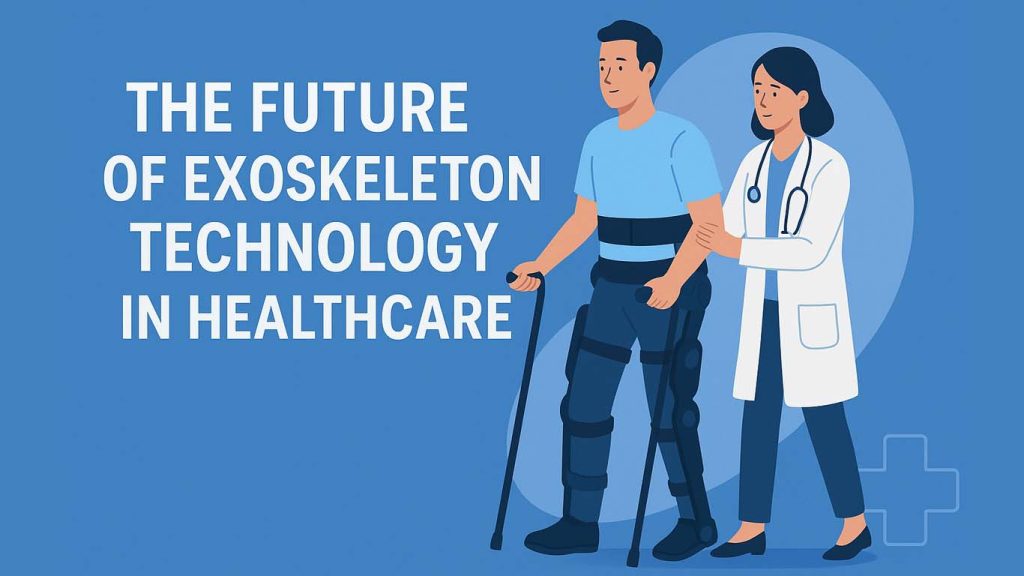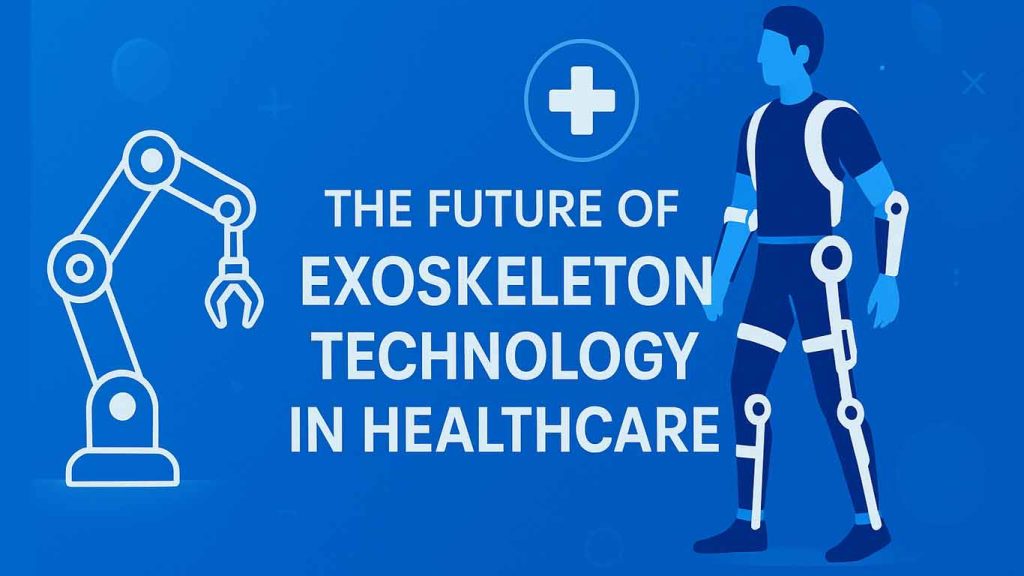
The Future of Exoskeleton Technology in Healthcare
Introduction
Healthcare is undergoing a remarkable transformation driven by advancements in robotics, artificial intelligence, biotechnology, and wearable devices. Among these innovations, exoskeleton technology stands out as one of the most promising solutions for enhancing human mobility, rehabilitation, and overall quality of life. Once confined to the realm of science fiction and military research, exoskeletons are now finding real-world applications in hospitals, rehabilitation centers, and even personal healthcare.
By 2025 and beyond, exoskeletons are expected to revolutionize the way patients recover from injuries, regain motor function, and lead more independent lives. This blog post explores the evolution, current state, and future of exoskeleton technology in healthcare, highlighting its benefits, challenges, and long-term societal impact.
Understanding Exoskeleton Technology
Exoskeletons are wearable robotic systems designed to augment, assist, or enhance human movement. They can be powered (motorized) or passive (mechanical), depending on the intended use. In healthcare, exoskeleton technology is mainly used to help individuals with mobility impairments, neurological disorders, or physical injuries.
There are three primary categories of medical exoskeletons:
- Rehabilitation Exoskeletons – Designed for patients recovering from strokes, spinal cord injuries, or other neurological conditions, helping them relearn walking and regain strength.
- Assistive Exoskeletons – Built for individuals with permanent disabilities, enabling them to walk, stand, or perform everyday activities independently.
- Therapeutic Exoskeletons – Used in clinical settings to provide repetitive, precise movements that stimulate muscle memory and neural regeneration.
The Evolution of Exoskeleton Technology
Exoskeletons have their roots in the mid-20th century when early prototypes were developed for military applications. In the 1960s, General Electric and the U.S. military introduced the Hardiman suit, a bulky machine aimed at enhancing soldier strength. However, it was impractical due to its weight and complexity.
Fast forward to the 21st century, improvements in robotics, lightweight materials, and artificial intelligence have transformed exoskeleton technology into functional healthcare solutions. The first medical exoskeletons entered the market in the early 2010s, designed primarily for spinal cord injury patients. Today, companies like ReWalk Robotics, Ekso Bionics, and CYBERDYNE are leading the charge in making these devices more accessible and efficient.
The Role of Exoskeleton Technology in Healthcare
1. Rehabilitation Therapy
Rehabilitation is one of the most impactful applications of exoskeleton technology. For stroke patients, spinal cord injury survivors, and individuals with neurological disorders like multiple sclerosis, exoskeletons provide structured, repetitive movement training. This helps:
- Improve motor function through neuroplasticity.
- Enhance muscle memory and coordination.
- Reduce the risk of secondary complications such as muscle atrophy and joint stiffness.
2. Restoring Independence
For patients with permanent disabilities, exoskeletons offer more than mobility—they restore dignity and independence. The ability to stand, walk, and engage in normal daily activities greatly improves mental health and social inclusion.
3. Reducing Healthcare Costs
While initial costs are high, exoskeletons can reduce long-term healthcare expenses by minimizing hospital stays, reducing caregiver dependency, and preventing secondary health issues caused by immobility (e.g., pressure sores, blood clots, osteoporosis).
4. Pain and Posture Management
Exoskeletons also play a vital role in pain reduction and posture correction. For example, patients suffering from musculoskeletal disorders or chronic back pain can benefit from wearable exoskeletons that reduce strain on joints and muscles.
Technological Advancements Driving Exoskeleton Adoption
The rapid progress of exoskeleton technology in healthcare is fueled by several technological innovations:
1. Artificial Intelligence (AI) Integration
AI enables exoskeletons to adapt to each user’s unique movement patterns. By analyzing gait, muscle signals, and balance, AI-driven exoskeletons can provide customized support in real time.
2. Lightweight Materials
Early exoskeletons were bulky and heavy, but modern designs use carbon fiber, aluminum alloys, and other lightweight composites, making them more comfortable for long-term use.
3. Brain-Computer Interfaces (BCIs)
One of the most exciting developments is the integration of BCIs, which allow patients to control exoskeletons using their brain signals. This is particularly revolutionary for patients with severe paralysis.
4. Battery Efficiency
Advances in battery technology now allow exoskeletons to run longer without frequent recharging, making them more practical for daily use.
5. Wearable Sensors
Embedded sensors in exoskeletons monitor muscle activity, joint angles, and balance, providing real-time feedback to optimize rehabilitation exercises.

Case Studies of Exoskeleton Use in Healthcare
ReWalk Robotics
ReWalk developed one of the first FDA-approved exoskeletons for spinal cord injury patients. Their device allows paraplegics to stand and walk again, significantly improving quality of life.
Ekso Bionics
Ekso Bionics produces rehabilitation exoskeletons widely used in hospitals and physical therapy centers worldwide. Their devices help stroke survivors relearn walking movements.
CYBERDYNE HAL (Hybrid Assistive Limb)
Japan’s CYBERDYNE created HAL, an exoskeleton that detects bioelectric signals from the skin surface, translating them into movement. This has shown promising results in rehabilitating patients with neuromuscular disorders.
Future Trends of Exoskeleton Technology in Healthcare
By 2030, exoskeleton technology in healthcare is expected to be more affordable, lightweight, and widely accessible. Key trends include:
1. Personalized Rehabilitation Programs
AI will allow therapists to design personalized training regimens for patients using exoskeletons, tracking progress with high precision.
2. Home-Based Exoskeleton Therapy
Currently, most exoskeleton use is confined to hospitals. In the future, compact and affordable models will allow patients to conduct rehabilitation at home, reducing the burden on healthcare systems.
3. Integration with Telemedicine
Exoskeletons equipped with IoT sensors will transmit patient progress data directly to doctors, enabling remote monitoring and adjustment of therapy.
4. Pediatric Exoskeletons
Research is expanding into pediatric applications, providing children with mobility impairments access to rehabilitation and movement assistance at an early age.
5. Affordable Mass Production
As production scales and technology matures, costs will decrease, making exoskeletons more widely available across developing nations.
Societal Impact of Exoskeleton Technology
Improved Quality of Life
Patients using exoskeletons report higher levels of confidence, mental health, and participation in social activities.
Healthcare System Transformation
Exoskeletons may reduce the demand for full-time caregivers and lessen the burden on hospitals and rehabilitation centers.
Economic Opportunities
The rise of exoskeleton technology in healthcare opens new markets for robotics companies, startups, and healthcare providers, driving economic growth and job creation.
Accessibility Challenges
Despite advancements, affordability remains a challenge. Governments and healthcare providers must step in to ensure equitable access.
Challenges Facing Exoskeleton Technology in Healthcare
- High Costs – Prices for medical exoskeletons can range from $50,000 to $150,000, making them inaccessible for most patients.
- Limited Insurance Coverage – Many insurance providers do not cover exoskeleton therapy, limiting adoption.
- Technical Limitations – Despite progress, exoskeletons are still slower and less flexible compared to natural human movement.
- Training Requirements – Patients and therapists require extensive training to use exoskeletons effectively.
- Ethical Concerns – Issues around accessibility, inequality, and dependency on technology must be addressed.
The Future Outlook: A Healthcare Revolution
By 2040, exoskeleton technology may become as common in hospitals as wheelchairs and prosthetics. With declining costs, improved functionality, and AI-powered personalization, exoskeletons will not only restore mobility but also redefine rehabilitation practices worldwide. Governments, healthcare institutions, and innovators will need to collaborate to ensure equitable access and ethical use.
The ultimate vision is a world where no individual is limited by physical disability or mobility impairment, thanks to the power of robotic assistance.
Conclusion
The future of exoskeleton technology in healthcare is bright and transformative. From rehabilitation to restoring independence and reducing long-term healthcare costs, exoskeletons are reshaping how we approach mobility and patient care. With rapid advancements in AI, sensors, and wearable robotics, the next decade will witness a healthcare revolution where exoskeletons play a central role.
While challenges such as cost, accessibility, and technical limitations remain, the long-term benefits far outweigh these obstacles. By 2025 and beyond, exoskeletons will not only redefine patient care but also empower millions of people worldwide to reclaim their independence and lead healthier, more fulfilling lives.
Frequently Asked Questions: The Future of Exoskeleton Technology in Healthcare
1. What is an exoskeleton in healthcare?
An exoskeleton is a wearable robotic device that supports or enhances body movement, often used in rehabilitation, mobility assistance, and strength enhancement for patients with physical impairments.
2. How do medical exoskeletons work?
They use a combination of sensors, motors, and artificial intelligence to detect a wearer’s movements and provide assistance. Some models amplify muscle strength, while others help patients relearn walking patterns after injury or illness.
3. Who can benefit most from exoskeleton technology in healthcare?
Patients with spinal cord injuries, stroke survivors, individuals with multiple sclerosis, muscular dystrophy, cerebral palsy, or age-related mobility issues can benefit significantly.
4. Are exoskeletons already used in hospitals?
Yes, many rehabilitation centers worldwide use exoskeletons to help patients regain mobility, particularly in stroke recovery and spinal cord injury therapy.
5. What role will exoskeletons play in rehabilitation?
They will revolutionize rehabilitation by enabling repetitive, precise, and intensive movement training—essential for neuroplasticity and faster recovery.
6. How can exoskeletons help elderly patients?
Exoskeletons can support weak muscles, improve balance, reduce fall risks, and allow elderly patients to maintain independence for longer.
7. Will future exoskeletons be lightweight and more comfortable?
Yes, ongoing research focuses on lighter materials (like carbon fiber and advanced polymers), ergonomic designs, and softer “exosuits” that feel less robotic and more natural.
8. What is the difference between rigid and soft exoskeletons?
- Rigid exoskeletons: Built with hard frames and motors, offering strong support.
- Soft exosuits: Made with flexible textiles and cables, designed for comfort and subtle movement assistance.
9. How do exoskeletons integrate with artificial intelligence?
AI helps personalize therapy by analyzing a patient’s movement data, predicting needed support, and adjusting real-time assistance levels for more effective rehabilitation.
10. Can exoskeletons replace wheelchairs in the future?
While they may not completely replace wheelchairs, exoskeletons can provide mobility options, reduce long-term complications of sitting, and improve quality of life for some users.
11. What are the psychological benefits of using exoskeletons?
Patients report improved self-esteem, reduced depression, and greater motivation because exoskeletons allow them to stand, walk, and interact at eye level again.
12. Are exoskeletons safe for patients?
Yes, most medical exoskeletons include safety features like fall-prevention systems, emergency shutoff, and supervised training to ensure safe usage.
13. How much do medical exoskeletons cost?
Currently, medical exoskeletons can cost between $40,000–$150,000, but prices are expected to decrease as technology advances and production scales up.
14. Will exoskeletons be covered by insurance in the future?
Some countries and insurers are beginning to provide partial coverage, especially for rehabilitation centers. Broader insurance approval is likely as clinical evidence of their benefits increases.
15. How will exoskeletons impact physical therapists?
Exoskeletons won’t replace therapists but will enhance their work by automating repetitive tasks and allowing therapists to focus on personalized care and treatment strategies.
16. What are the limitations of current exoskeletons?
- High cost
- Bulky designs
- Limited battery life
- Restricted availability
- Need for professional supervision
17. What future improvements can we expect?
- Longer-lasting batteries
- Smaller, lighter designs
- AI-driven personalized rehabilitation programs
- Home-use exoskeletons for daily life assistance
18. Can exoskeletons prevent injuries in healthcare workers?
Yes, exoskeletons designed for caregivers can reduce strain when lifting or moving patients, helping prevent back injuries and improving workplace safety.
19. Will exoskeletons make surgery more effective?
Future surgical exoskeletons may enhance surgeons’ precision, stability, and endurance during long procedures, leading to improved outcomes.
20. What is the long-term vision of exoskeletons in healthcare?
The ultimate goal is to create accessible, affordable, and adaptive exoskeletons that integrate seamlessly into everyday life, empowering patients to live independently and supporting healthcare professionals in delivering better care.
Related:
